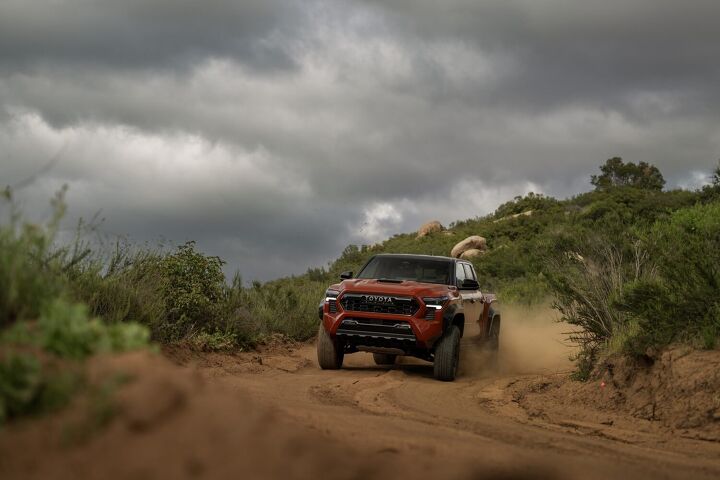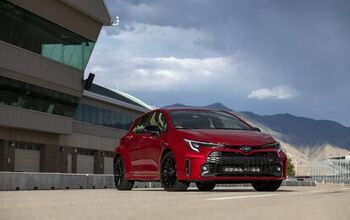2024 Toyota Tacoma Hybrid Pricing and Specs Revealed

Toyota has released details on the Tacoma Hybrid, showing it will start at $47,795 as part of the TRD Sport trim. While that’s nearly $7,000 more than the gasoline variant of the TRD Sport, it does come equipped with the more powerful i-Force Max powertrain.
That unit offers a combined total of 326 horsepower and 465 pound-feet of torque, a significant improvement over the gasoline-only models. However, with a maximum towing capacity of 6,000 pounds, the 2.4-liter engine with a 48-hp hybrid electric motor integrated into the 8-speed transmission may not offer that much more utility. The outgoing V6 models topped out at 6,800 pounds and the new 278 hp 2.4-liter gas-powered engine is supposed to be capable of 6,500 pounds when equipped with the proper towing package.
Hybrid models look to be sold at a healthy premium over gasoline-only models. But not all trims are equal. For example, TRD Off-Road model is only $4,800 more when outfitted as a hybrid. Higher trims seem to have even less difference between the hybrid vs non-hybrid models, though you can still reliably count on spending a few thousand more in all cases.
The exception here is the Toyota Tacoma TRD Pro and Trailhunter. Both of those will come with the hybrid i-Force powertrain as standard equipment and start near the $65,000 mark. That’s expensive for a midsize pickup. But they also come with loads of off-road goodies — like upgraded underbody protection, aggressive tires, beefed-up suspensions, helpful driving modes, etc. — and plenty of interior upgrades.
While we assume the hybrid will probably draw in some customers seeking to save on fuel costs, Toyota expects the Tacoma hybrid to net a combined EPA fuel economy rating of 23 or 24 mpg depending on the trim. That’s only a couple miles to the gallon better than the non-hybrid trims and quite a bit less than one might receive from a smaller truck. The Ford Maverick may not be able to haul nearly as much stuff, but it’s still a truck and one that’s quite a bit more fuel efficient than the Tacoma.
Hybrid versions of the Ford Maverick boast an EPA average of 42 mpg in town and 33 in on the highway. Meanwhile, the non-hybrid version still manages 23 mpg in the city and 30 on the open road. Things are much closer when you’re comparing trucks sized more closely to the Tacoma. But even here, the Ford Ranger outperforms by a few mpg while other brand’s are offering models that are close enough for it not to make much difference.
The above probably won’t decide which pickup someone will settle on. But it may sway drivers who are trying to decide whether the peppier i-Force Max is worth the extra cost.
[Images: Toyota]
Become a TTAC insider. Get the latest news, features, TTAC takes, and everything else that gets to the truth about cars first by subscribing to our newsletter.

A staunch consumer advocate tracking industry trends and regulation. Before joining TTAC, Matt spent a decade working for marketing and research firms based in NYC. Clients included several of the world’s largest automakers, global tire brands, and aftermarket part suppliers. Dissatisfied with the corporate world and resentful of having to wear suits everyday, he pivoted to writing about cars. Since then, that man has become an ardent supporter of the right-to-repair movement, been interviewed on the auto industry by national radio broadcasts, driven more rental cars than anyone ever should, participated in amateur rallying events, and received the requisite minimum training as sanctioned by the SCCA. Handy with a wrench, Matt grew up surrounded by Detroit auto workers and managed to get a pizza delivery job before he was legally eligible. He later found himself driving box trucks through Manhattan, guaranteeing future sympathy for actual truckers. He continues to conduct research pertaining to the automotive sector as an independent contractor and has since moved back to his native Michigan, closer to where the cars are born. A contrarian, Matt claims to prefer understeer — stating that front and all-wheel drive vehicles cater best to his driving style.
More by Matt Posky
Latest Car Reviews
Read moreLatest Product Reviews
Read moreRecent Comments
- Dartdude Having the queen of nothing as the head of Dodge is a recipe for disaster. She hasn't done anything with Chrysler for 4 years, May as well fold up Chrysler and Dodge.
- Pau65792686 I think there is a need for more sedans. Some people would rather drive a car over SUV’s or CUV’s. If Honda and Toyota can do it why not American brands. We need more affordable sedans.
- Tassos Obsolete relic is NOT a used car.It might have attracted some buyers in ITS DAY, 1985, 40 years ago, but NOT today, unless you are a damned fool.
- Stan Reither Jr. Part throttle efficiency was mentioned earlier in a postThis type of reciprocating engine opens the door to achieve(slightly) variable stroke which would provide variable mechanical compression ratio adjustments for high vacuum (light load) or boost(power) conditions IMO
- Joe65688619 Keep in mind some of these suppliers are not just supplying parts, but assembled components (easy example is transmissions). But there are far more, and the more they are electronically connected and integrated with rest of the platform the more complex to design, engineer, and manufacture. Most contract manufacturers don't make a lot of money in the design and engineering space because their customers to that. Commodity components can be sourced anywhere, but there are only a handful of contract manufacturers (usually diversified companies that build all kinds of stuff for other brands) can engineer and build the more complex components, especially with electronics. Every single new car I've purchased in the last few years has had some sort of electronic component issue: Infinti (battery drain caused by software bug and poorly grounded wires), Acura (radio hiss, pops, burps, dash and infotainment screens occasionally throw errors and the ignition must be killed to reboot them, voice nav, whether using the car's system or CarPlay can't seem to make up its mind as to which speakers to use and how loud, even using the same app on the same trip - I almost jumped in my seat once), GMC drivetrain EMF causing a whine in the speakers that even when "off" that phased with engine RPM), Nissan (didn't have issues until 120K miles, but occassionally blew fuses for interior components - likely not a manufacturing defect other than a short developed somewhere, but on a high-mileage car that was mechanically sound was too expensive to fix (a lot of trial and error and tracing connections = labor costs). What I suspect will happen is that only the largest commodity suppliers that can really leverage their supply chain will remain, and for the more complex components (think bumper assemblies or the electronics for them supporting all kinds of sensors) will likley consolidate to a handful of manufacturers who may eventually specialize in what they produce. This is part of the reason why seemingly minor crashes cost so much - an auto brand does nst have the parts on hand to replace an integrated sensor , nor the expertice as they never built them, but bought them). And their suppliers, in attempt to cut costs, build them in way that is cheap to manufacture (not necessarily poorly bulit) but difficult to replace without swapping entire assemblies or units).I've love to see an article on repair costs and how those are impacting insurance rates. You almost need gap insurance now because of how quickly cars depreciate yet remain expensive to fix (orders more to originally build, in some cases). No way I would buy a CyberTruck - don't want one, but if I did, this would stop me. And it's not just EVs.





































Comments
Join the conversation
Lou_BC
one of many cars I sold when I got commissioned into the army. 1964 Dodge D100 with slant six and 3 on the tree, 1973 Plymouth Duster with slant six, 1974 dodge dart custom with a 318. 1990 Bronco 5.0 which was our snowboard rig for Wa state and Whistler/Blackcomb BC. Now :my trail rigs are a 1985 Toyota FJ60 Land cruiser and 86 Suzuki Samurai.
Yes all the Older Land Cruiser’s and samurai’s have gone up here as well. I’ve taken both vehicle ps on some pretty rough roads exploring old mine shafts etc. I bought mine right before I deployed back in 08 and got it for $4000 and also bought another that is non running for parts, got a complete engine, drive train. The mice love it unfortunately.